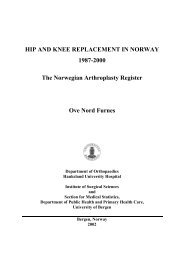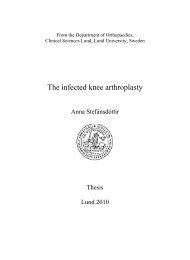E-Book German Arthroplasty Register EPRD - EAR - EFORT
E-Book German Arthroplasty Register EPRD - EAR - EFORT
E-Book German Arthroplasty Register EPRD - EAR - EFORT
Create successful ePaper yourself
Turn your PDF publications into a flip-book with our unique Google optimized e-Paper software.
The <strong>German</strong> <strong>Arthroplasty</strong> <strong>Register</strong> is supposed<br />
to provide a nationwide record of<br />
implant survival times. Data collection is<br />
organised in such a way as to keep additional<br />
administrative processing at a minimum,<br />
which was an essential goal in project planning,<br />
and strictly adheres to the existing data<br />
protection regulations (18). As important<br />
stakeholders in health care, apart from the<br />
Orthopaedic Society also major health care<br />
insurance providers, impant manufacturers,<br />
and the BQS Institute [Institute for Quality<br />
and Patient Safety; translator’s note] are<br />
directly involved to ensure long-term operation<br />
of the <strong>Register</strong> and cross-functional<br />
cooperation.<br />
The <strong>German</strong> Association of Orthopaedics<br />
and Orthopaedic Surgery (DGOOC) had<br />
been trying to establish an arthroplasty<br />
register for nearly two decades. From 1997<br />
the Deutsche Endoprothesenregister e.V.<br />
[”<strong>German</strong> <strong>Arthroplasty</strong> <strong>Register</strong> Association“;<br />
translator’s note] collected arthroplasty data<br />
on a voluntary basis (19). However, when<br />
BQS started nationwide collection of structural<br />
and process quality data, this register<br />
was ceased not least due to lack of systematic<br />
funding. Subsequently comprehensive<br />
concepts were drawn up for a statutory<br />
<strong>Arthroplasty</strong> <strong>Register</strong> organised through<br />
External Quality Assurance. In 2009, after the<br />
<strong>German</strong> External Quality Assurance provider<br />
had been changed, the implementation of<br />
a National <strong>Arthroplasty</strong> <strong>Register</strong> could no<br />
longer be expected to be realised in the<br />
short to medium run.<br />
In 2010 the <strong>German</strong> Association of Orthopaedics<br />
and Orthopaedic Surgery (DGOOC)<br />
The <strong>German</strong><br />
<strong>Arthroplasty</strong> <strong>Register</strong><br />
(<strong>EPRD</strong>)<br />
therefore initiated the foundation<br />
of the <strong>German</strong> Arthro- 3. Aims and Organisational<br />
plasty <strong>Register</strong> “Endopro-<br />
Structure<br />
thesenregister Deutschland<br />
gGmbH” (<strong>EPRD</strong>). The <strong>EPRD</strong> is a not-for-profit society and<br />
a subsidiary of the scientific National Orthopaedic Association<br />
DGOOC (see p.11). Structured cooperation was<br />
built up across long existing sectoral boundaries among<br />
the Orthopaedic Society (DGOOC), the <strong>Arthroplasty</strong> and<br />
Implants Division within the <strong>German</strong> Medical Technology<br />
Association (BVMed), and the hospitals. On the initiative<br />
of the DGOOC the essential key partners in health<br />
care – the Federation of Local Health Insurance Funds<br />
(AOK-Bundesverband), the Association of Substitute<br />
Health Insurance Funds (vdek – Verband der Ersatzkassen),<br />
implant manufacturers via the BVMed, as well as<br />
the BQS Institute – joined forces in a common project,<br />
the <strong>EPRD</strong>. As Members of the Executive Committee all<br />
partners have a decisive share in steering the <strong>German</strong><br />
<strong>Arthroplasty</strong> <strong>Register</strong>. They are supported by a Council<br />
composed of high-ranking personalities from the public,<br />
political and scientific sector.<br />
To give appropriate consideration to all requirements<br />
including statutory provisions, the <strong>EPRD</strong> has concluded<br />
mutual, long-term agreements with all partners. The<br />
financing concept provides balanced contributions<br />
from health insurance providers, manufacturers and the<br />
hospitals.<br />
The findings obtained will be made accessible to the<br />
scientific community as well as to the general public<br />
through regular evaluations, publications and presentations.<br />
Through close feedback via the Orthopaedic<br />
Society these findings can be implemented in everyday<br />
treatment practice directly and in the short run, which<br />
will lead to an increase in patient safety.<br />
Structure, Procedures and Organisation<br />
7









